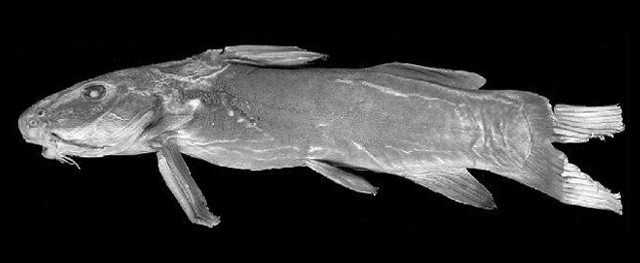|
Dorsal spines (total): 2-2; Dorsal soft rays (total): 6-6; Anal spines: 0-0; Anal soft rays: 12-12; Vertebrae: 46-46. Diagnosis: Gogo brevibarbis is distinguished from other members of Anchariidae in having bicuspid teeth on the upper and lower jaws vs. unicuspid (Ref. 56142). It can be further distinguished from Gogo arcuatus in having a straight dorsoposterior margin of the dorsal fin vs. concave; and from G. ornatus in having a larger eye, 15.9% of head length vs. 9.2-13.6% (Ref. 56142).
Description: Body cylindrical, becoming more laterally compressed toward caudal peduncle (Ref. 56142). Dorsal profile gently convex from dorsal-spine base to anterior orbital margin, nearly straight anterior of orbit; dorsal profile horizontal from dorsal-fin origin to middle of adipose-fin base, then sloping gently ventrally to end of caudal peduncle; ventral profile almost horizontal to anal-fin base, then sloping gently dorsally to end of caudal peduncle (Ref. 56142). Head moderately depressed; dorsal profile slightly convex and ventral profile almost straight (Ref. 56142). Bony elements of dorsal surface of head covered with thick skin, although granular surface of neurocranium faintly visible in inter- and postorbital region; supraoccipital spine short and broad, with gently converging sides and blunt tip; in contact with anterior nuchal plate (Ref. 56142). Eye ovoid, horizontal axis longest, with free margin; located entirely in dorsal half of head (Ref. 56142). Gill openings wide, extending from ventral to posttemporal region to isthmus at vertical through anterior orbital margin; gill membranes broadly fused to each other and attached to isthmus, save for narrow flap along posterior margin at isthmus; gently notched at ventral midline (Ref. 56142). Snout strongly produced and bulbous, with rounded profile in lateral view; mouth inferior; oral teeth small and bicuspid on both upper and lower jaws; in irregular rows on all tooth-bearing surfaces; premaxillary tooth band broad and crescentic, of equal width throughout; dentary tooth band in two semicrescentic patches separated at midline; much narrower than premaxillary tooth band at symphysis (Ref.56142). Barbels in three pairs; maxillary barbel short, thick and flattened, extending two thirds of distance between its base and base of pectoral spine; maxillary barbel with membranous extension along posterior edge; extension flaring posteriorly on proximal half of barbel; inner mandibular-barbel origin proximal to midline; barbel thick and flat; extending to vertical through anterior orbital margin; outer mandibular barbel originating posterolateral to inner mandibular barbel; thick and flat, and extending to vertical through posterior orbital margin (Ref. 56142). Dorsal fin with spinelet, spine, and 6 rays; dorsal-fin origin anterior to mid-body, at about two-fifths of body length; dorsal-fin margin straight, with first branched ray not significantly longer than other fin rays; dorsal-fin spine long, straight and slender, adpressed spine not reaching origin of adipose fin; anterior and posterior margins of spine smooth; anterior nuchal plate rectangular, closely sutured to supraoccipital process; median nuchal plate with truncate anterior tip (Ref. 56142). Pectoral fin with stout spine, sharply pointed at tip, and 9 rays; anterior spine margin with a series of irregular shallow asperities for entire length, posterior spine margin with 11 weak, retrorse serrations along distal half of spine; pectoral fin triangular, with straight anterior and posterior margins; humeral process short and slender, with concave dorsal edge; extending to middle of anterior nuchal plate (Ref. 56142). Pelvic-fin origin at vertical through midpoint between posterior margin of dorsal-fin base and adipose-fin origin, with i,5 rays and slightly convex margin; tip of adpressed fin not reaching anal-fin origin; anus and urogenital openings located at vertical through midpoint of adpressed pelvic fin (Ref. 56142). Adipose fin with convex margin along entire length; deeply-incised posteriorly; length of adipose base approximately 1.5 times length of anal-fin base (Ref. 56142). Anal-fin origin located at vertical through posterior half of adipose fin; fin with iv,8 rays and straight posterior margin (Ref. 56142). Caudal peduncle deep; caudal fin moderately forked, with i,6,7,i principal rays; upper and lower caudal lobes broad, pointed distally, and approximately equal in length; procurrent rays extending only slightly anterior to fin base (Ref. 56142). Skin smooth; lateral line complete; canal running along lateral myoseptum, with pores emanating from short ventrally and dorsally directed oblique branches (Ref. 56142).
Colouration: Ground colouration in ethanol uniform brown on dorsal and lateral surfaces of head and body, fading to cream on ventral surfaces; adipose fin, and fin rays and membranes of median fins, brown; paired fins with similar colouration as body dorsally, cream ventrally (Ref. 56142). |

